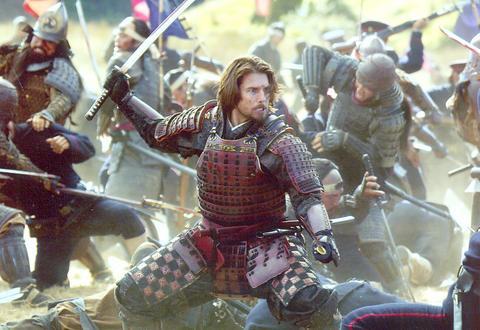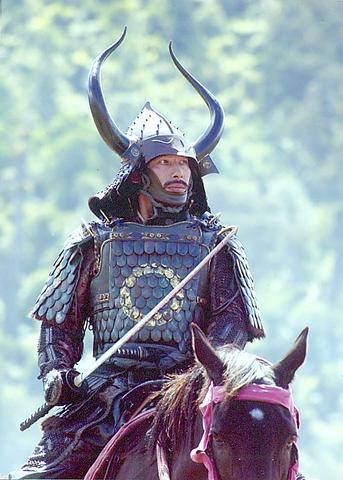There is probably no director more obsessed with the complexity of patriotism -- an unusual subject to plumb in mainstream films -- than Edward Zwick, who is driven to question the imperatives of an America that his protagonists both love and detest. His latest movie, The Last Samurai, falls squarely into the realm of the previous Zwick bedeviled-hero films, Glory, Courage Under Fire and The Siege.
And I do mean squarely. Samurai is a mythic western that combines a fish-out-of-water theme with an immersion in Japanese culture: John Ford's Lost in Translation. It depicts phalanxes of troops moving with deliberate, terrifying fervor across the very wide screen.

And this time Tom Cruise, the can-do idol of millions, uses his polished-chrome smile mirthlessly. At least for the first hour, his grin looks like a faded tattoo. The uneven Samurai is a can-do movie that's far more effective at communicating emotion in bigger scenes than in more intimate ones.

Cruise plays Nathan Algren, a burned-out former Army officer and Indian fighter. Having survived Custer's Last Stand in 1876, he is now a commercial sideshow prop, demonstrating the newest Winchester rifle. As Algren lumbers through the cliches he's hired to recite before blasting away at targets -- though the whiskey oozing from his pores probably makes him more of a danger than the weapon -- a sudden ember of regret flames in this ex-soldier's eyes. He goes off the script, reciting the horrors of a campaign in which he and his troops slaughtered innocents.
Algren looks so wasted and beleaguered that the biggest question is not whether he'll wing an audience member with a stray shot, but whether he can bear up under the dense, cast-iron plot. After being bounced by the Winchester folks, Algren is hired by his former commander, Colonel Bagley (Tony Goldwyn, playing a salamander-like ancestor of all the sleazy characters he's ever portrayed). Bagley wants Algren to travel with him to Tokyo and train Japanese soldiers in the use of American tactics and rifles. The Meiji emperor is ready to accept the ways of the West; he's actually being pressured to by American business interests.
Once in Japan, Algren is forced to send his nervous, underprepared imperial troops into battle too soon against an enemy of the emperor, the samurai Katsumoto (Ken Watanabe). Despite the imperial army's modern weapons, Katsumoto and his men sweep in with ferocity and wield their arms of the past -- swords and spears -- with lethal effectiveness. The cinematographer, John Toll, films their arrival through a thick fog in a forest, as if Katsumoto's men were ghosts from the recent past out to rob Algren's troops of their backbones -- and their lives.
In their ritual armor, Katsumoto's men make quick work of their foes; there's tragicomic relief as Algren's conscripted farmers tremble while trying to load their guns. When a wounded Algren kills Katsumoto's second in command, he's captured by the invaders and, even more bewildering, cared for by Katsumoto's sister, Taka (Koyuki), the widow of the man Algren murdered.
It's a complicated story, and Zwick is complicated, too: he loves arrogance slapped out of its self-regard. Algren is full of himself, even though he's conceived as a man who was second tenor to a legend; he knew and despised Custer. Looking fashionably distressed, with slightly puffy, red-rimmed eyes that at the very least suggest that he's survived a grueling press junket, Cruise has a worn cockiness. His aw-shucks virility is a little wilted, if not mildewed, around the edges: a kind of reverse narcissism, since Algren is proud of his dissolution (though Cruise's good-boy posture works for a man reared under the disciplinary rigors of the military).
Although at times Cruise comes off as too contemporary for the 19th century -- at one point, he seems to be waiting for a cellphone call to confirm his terms for a cover of Details magazine -- this displacement fits better when he becomes a prisoner. Algren appears to be reacting to this strange new world through sounds; nothing he's hearing makes any sense to him. He's a mangy gaijin that Edgar Rice Burroughs might have invented, though James Clavell got there eventually.
The film includes notable performances by actors not drafted to shoulder the burden of the entire production. Billy Connolly, emanating a gamy, sly menace that he's rarely suggested before, plays Algren's former sergeant at arms, Zebulon Gant. Gant, used to propping up his old friend and superior officer, joins Algren in the journey to Japan. Connolly's loose, hostile vivacity registers so clearly that it's obvious we won't be seeing very much of him. But this is crackling, rigorous comic work; he doesn't have to present the face of tragedy.
The far more weighted and daring acting comes from Watanabe, as Katsumoto. Probably best known outside of Japan as the reedy, restless sidekick in the gourmand classic Tampopo, Watanabe has filled out physically and spiritually. The formality he brings to Katsumoto is hard-won, especially when he's having pointedly thoughtful conversations with Algren that sound more like translations of ideograms than actual dialogue.
The film never really explains how or why this resolute, isolated samurai learned to speak English better than the emperor. His fluency doesn't quite make sense, though it gives the movie some needed mystique. It plays better than the inexorable pull of romance, drawing Taka and Algren together.
The Last Samurai, which Zwick and Marshall Herskovitz wrote with John Logan, from a story by Logan, super-glues together a host of contradictions. Unfortunately, as dramatized, they function as conventions that are older than the story the film is weaving. The movie, which opens in Taiwan today, is most watchable during the majestic brutality of the battle sequences. This is not only because of the handsome staging, but also because the keywords sacrifice and honor are evoked with verve and simplicity, more so than in the "exchange of idea" chats between Algren and Katsumoto, which sound like statements being read into the Congressional Record by Nathaniel Hawthorne.
Zwick has absorbed the lethal agility of Akira Kurosawa; what registers just as powerfully as the sureness of the combatants is the ugly futility of the battles themselves. When the film sets up the lessons that Algren has to learn, the hero is not really a fish out of water; he's more like a big fish in a dry pond, picking up a lesson in Eastern deportment and philosophy a step away from the "wax-on, wax-off" curriculum of The Karate Kid. In those scenes presaging his Eastern conversion, Algren can't suppress his eagerness to learn, picking up the ways of the sword and the Samurai code of Bushido with an alacrity that's mandated for movie stars: flash-card education.

June 23 to June 29 After capturing the walled city of Hsinchu on June 22, 1895, the Japanese hoped to quickly push south and seize control of Taiwan’s entire west coast — but their advance was stalled for more than a month. Not only did local Hakka fighters continue to cause them headaches, resistance forces even attempted to retake the city three times. “We had planned to occupy Anping (Tainan) and Takao (Kaohsiung) as soon as possible, but ever since we took Hsinchu, nearby bandits proclaiming to be ‘righteous people’ (義民) have been destroying train tracks and electrical cables, and gathering in villages

Swooping low over the banks of a Nile River tributary, an aid flight run by retired American military officers released a stream of food-stuffed sacks over a town emptied by fighting in South Sudan, a country wracked by conflict. Last week’s air drop was the latest in a controversial development — private contracting firms led by former US intelligence officers and military veterans delivering aid to some of the world’s deadliest conflict zones, in operations organized with governments that are combatants in the conflicts. The moves are roiling the global aid community, which warns of a more militarized, politicized and profit-seeking trend

The wide-screen spectacle of Formula One gets a gleaming, rip-roaring workout in Joseph Kosinski’s F1, a fine-tuned machine of a movie that, in its most riveting racing scenes, approaches a kind of high-speed splendor. Kosinski, who last endeavored to put moviegoers in the seat of a fighter jet in Top Gun: Maverick, has moved to the open cockpits of Formula One with much the same affection, if not outright need, for speed. A lot of the same team is back. Jerry Bruckheimer produces. Ehren Kruger, a co-writer on Maverick, takes sole credit here. Hans Zimmer, a co-composer previously, supplies the thumping

Dr. Y. Tony Yang, Associate Dean of Health Policy and Population Science at George Washington University, argued last week in a piece for the Taipei Times about former president Ma Ying-jeou (馬英九) leading a student delegation to the People’s Republic of China (PRC) that, “The real question is not whether Ma’s visit helps or hurts Taiwan — it is why Taiwan lacks a sophisticated, multi-track approach to one of the most complex geopolitical relationships in the world” (“Ma’s Visit, DPP’s Blind Spot,” June 18, page 8). Yang contends that the Democratic Progressive Party (DPP) has a blind spot: “By treating any